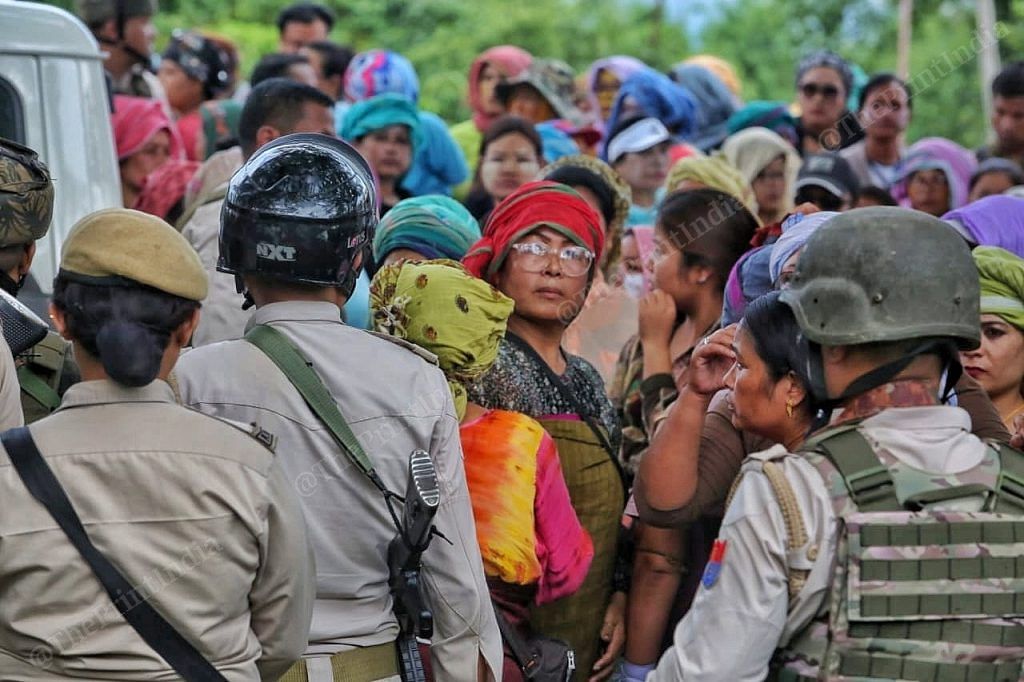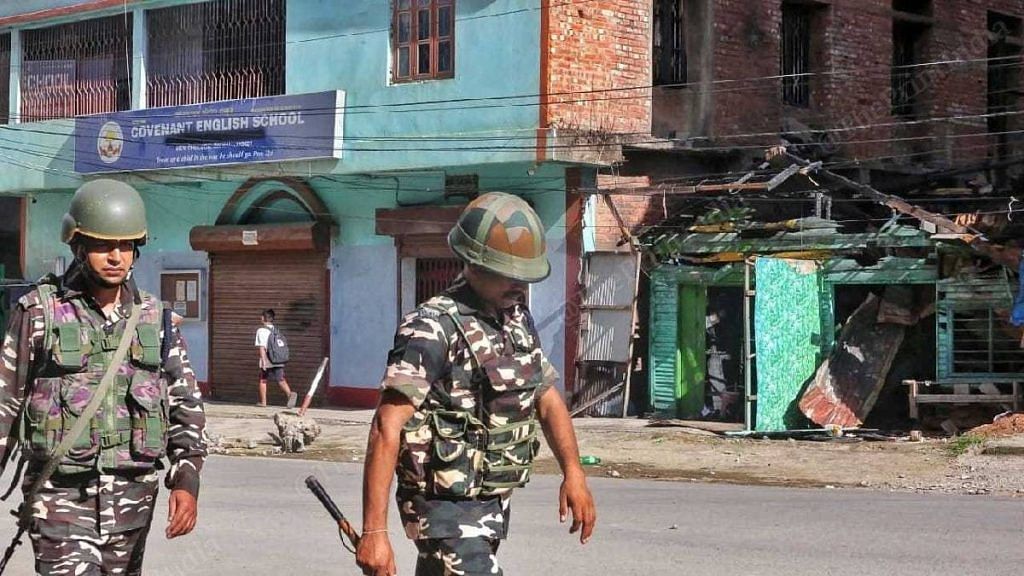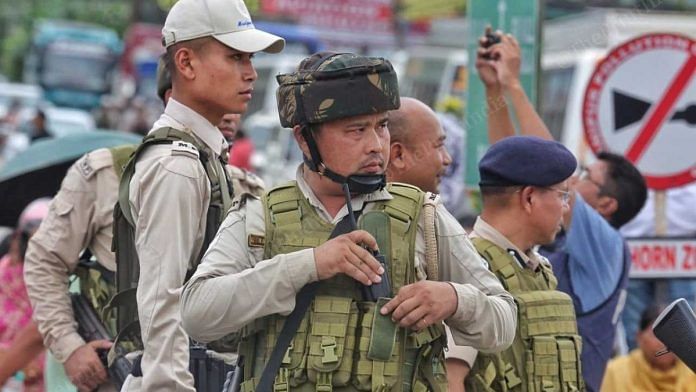Imphal: Arson, murder, rape, abduction — these are among the chilling crimes accounting for the 6,496 FIRs registered in Manipur since ethnic violence broke out on 3 May. However, only 280 arrests have been made, and investigations have not even started in most cases due to the “broken” law and order situation, police sources told ThePrint.
Police records provide a glimpse of the grim landscape in Manipur since 3 May: 74 murders, 24 abductions, 27 missing individuals, 30 instances of arms looting, and 11 attacks on women and children, including three sexual assaults. Arson takes the lead, with a staggering 5,107 cases, reflecting widespread destruction—from burned homes to vandalised properties and levelled structures.
However, these registered cases fail to capture the full extent of the violence gripping Manipur, even three months after the conflict erupted between the majority Meitei and tribal Kuki communities.
Thousands of Zero FIRs scattered across all 16 districts of Manipur, documenting murders, the missing, and more are yet to even be processed. These FIRS were filed in jurisdictions distant from the actual crime scenes, as a result of large-scale migrations of tribal Kukis from the Meitei-dominated Imphal valley, and of Meiteis from the Kuki-dominated hill districts.
Now, such FIRs remain unattended since the police are unable to physically transfer them to the appropriate police stations due to blockades imposed by locals.
“The investigation will start once the FIRs reach the designated police stations. If that is stopped, how will any work start?” asked a senior police officer from the hill district of Churachandpur, speaking to ThePrint.
This Tuesday, the Supreme Court castigated the Manipur police for the “lethargic” pace of its investigations into cases related to the ethnic violence. The court also decried the “complete breakdown” of law and order and constitutional machinery in Manipur, and summoned the state director general of police (DGP) for the next hearing on August 7.
However, police officers who spoke to ThePrint shed light on a host of challenges— resistance from locals, the pressure of grappling with daily outbreaks of conflict, the ambiguity of FIRs where the accused are listed only as “unidentified assailants”, and even the issue of ethnic biases creeping into investigations.
A recurring sentiment among senior police officials is that without a semblance of law and order, the necessary groundwork for investigations cannot be laid.
“Till the law-and-order situation stabilises, comprehensive investigations remain a distant goal,” said a senior police officer from Imphal. “We are doing our level best to ensure that all FIRs are looked into, but the sheer number of cases is overwhelming.”
Thousands of ‘stranded’ FIRs
The police in Manipur claim they encounter formidable challenges in transferring crucial documents, including FIRs, between their headquarters in Imphal and the Kuki-dominated hill districts.
Officers say Meitei matriarchs known as Meira Paibis have played a major role in obstructing investigations. These women have assumed a vigilante role, conducting checks of police vehicles along the Imphal-Churachandpur highway and destroying certain documents.
“If Meira Paibis discover police files with ‘Churachandpur’ written on them, they burn them, which is why we are now resorting to different ways of transporting these files,” the Churachandpur police officer said.

A second police officer from Imphal East told ThePrint that it took them over a month to send an FIR from Imphal East to Kuki-dominated Moreh in the hills because locals were not “allowing” files to be moved.
Imphal East alone has over 2,000 Zero FIRs stranded within police stations, the officer added.
“Just imagine, if a few FIRs are taking a month to reach the designated place, how much time will these thousands of FIRs take? And when will the investigation begin?” the officer asked.
“The locals stop police vehicles and check them. If the files of these FIRs get destroyed, burnt in the process of transfer, there will be no record left. It is a very challenging situation even for the police,” he further pointed out.
One stopgap solution employed by the police is using “human couriers” to ferry across FIRs.
Usually, a Muslim policeman or driver is sent to get files across, the Churachandpur officer said. However, he noted that this was a “risky proposition” since even a “courier” from a neutral community risked being attacked if caught carrying files deemed objectionable by locals.
A third senior police officer told ThePrint that since the violence in Manipur is yet to abate, most of the force is caught up in “law and order duties”
“We get frantic calls from people even at the slightest movement of any crowd outside their homes. So many places are still hotspots where incidents of firing are being reported on a daily basis,” he said. “We have to be on our toes.”
Catch and release?
According to police data, of the 280 people who were arrested between early May and 25 July, only 84 were sent to judicial custody, while the rest have been granted bail.
In the same period, police also recorded 14,898 general arrests, classified as “preventive detention”, but all individuals were released within 24 hours.
Police sources said that difficulties abound in Manipur when it comes to arresting and producing suspects in court.
Both in the valley and hill regions, community-led armed crowds often intervene during arrests, compelling the police to release detainees. In some instances, these mobs even appear outside courtrooms or judges’ residences during the accused’s appearances, police sources said.
Because of this situation, the police have had to make alternative arrangements for hearings, at times involving magistrates visiting police stations.
“If we make any arrests, a crowd from the person’s community gathers and corners us, forcing us to release the accused. They get violent and do not allow us to function. It is extremely difficult to make arrests,” the second officer from Imphal said.
The hill districts face another issue: a lack of jail infrastructure. Even if arrests are made, there is no suitable place to detain the accused, as the only functional prison is located in the Meitei-dominated Imphal valley.

Transporting arrested individuals from the hills to the valley poses further risks, with the potential for interception and violence, the Churachandpur police officer pointed out.
Consequently, judges are often compelled to grant bail to the accused on the very day of arrest.
“There is only one jail (in Imphal). We cannot arrest people from the hills and take the risk of transporting them to the valley, they will be stopped midway and probably lynched by the Meitei. This is the reason that even the magistrates are compelled to give them bail on the same day of arrest,” the officer added.
‘No place for fair investigations’
The ethnic divisions in Manipur have also permeated the police force, posing a significant obstacle to conducting fair investigations.
In early May, more than 1,500 Meitei and Kuki policemen went ‘missing’ from duty, only for some to reappear in police stations close to their homes days later, sources said.
The Kuki officers assigned to the Meitei-dominated Imphal valley retreated to the hills, while Meitei officers stationed in Kuki areas refused to return, exacerbating the divide. Some officers went on leave, others were reposted closer to home, and 50 remain missing.
Ethnic divisions have also affected how cases related to the violence are handled.
Complaints from Kukis about their ravaged villages in the valley were allegedly not registered in Imphal, where Meiteis hold sway over the police stations. Conversely, cases filed by Meiteis regarding losses in Kuki-dominated areas were purportedly left unaddressed there.
The rift has also led to accusations that the police are colluding with miscreants from their own communities.
“The divide is so deep that it is impossible to expect a fair investigation. If a Kuki officer is given a case of a Meitei complainant, his bias will stop him from carrying out a proper investigation and vice versa. This is no allegation but the actual ground situation,” a source in the security establishment told ThePrint.
“There is a need for an independent body, a special investigation unit, that can look into these cases,” the source added.
Tracing nameless mobs
The majority of FIRs registered in connection with the violence in Manipur are against “unidentified assailants” who were part of large mobs.
So far, more than 155 people have been killed and at least 670 injured in the conflict, and almost all were victims of armed mobs.
“There are so many such cases registered across Manipur where the assailants are unidentified, and there are also no eyewitnesses or CCTV footage available,” the security establishment source said.
“Over three months have passed and investigation in these cases have not reached anywhere. It is going to be a mammoth task for the police to pick these up, cases by case, and start the investigation, make arrests,” he added.
The police, however, said that they are making all attempts to begin investigations. The Imphal officer, however, acknowledged that it is a big problem as there is no support from the local population.
“We have made small teams to look at respective cases. People are being identified and arrested, but it is a challenge. The public is not very forthcoming in providing leads. We have recovered CCTV footage from several places and are trying to identify the people, but it is a cumbersome task,” the officer said.
As reported earlier by ThePrint, data from the Bureau of Police Research and Development shows that Manipur has a sanctioned police strength of 25,080, with an actual strength of 28,894. Among them, 15,200 serve in the civil police, 6,236 in various units of the armed police, and 7,458 in the centrally funded Indian Reserve Battalion (IRB).
There is one police officer per 108.98 citizens on the rolls, which is the third-highest ratio in the country after Nagaland and the Andaman and Nicobar Islands.
Nevertheless, as in most states, the budget allocated to the police remains relatively modest. In 2021, it accounted for Rs 1,901 crore out of a total budget of Rs 20,222 crore in Manipur.
(Edited by Asavari Singh)
Also Read: In Manipur, it’s Kuki vs Meitei cops — how unrest exposed ‘ethnic’ faultlines within state police



